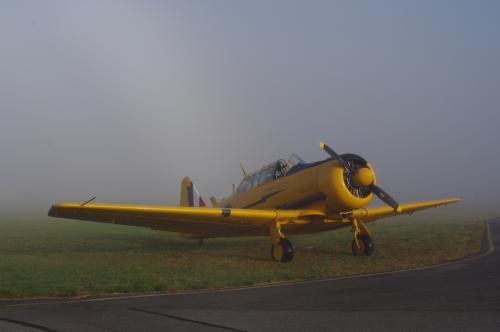
The History of North American Aviation
In December, 1928, North American Aviation was incorporated in Delaware to become a holding company. North American Aviation, Inc., had interests in a number of leading airlines and aircraft manufacturing companies including the General Aviation Manufacturing Corporation, located at Dundalk, Md. Legislation enacted during the Depression prevented an organization engaged in any part of the aircraft industry from holding an airmail contract. Therefore, North American’s airline interests were separated from its airplane-building concerns, and 39-year-old James Howard “Dutch” Kindelberger became President and General Manager of General Aviation, leaving a career as vice president of engineering at Douglas Aircraft.
Because Southern California had excellent year-round flying weather, Kindelberger moved the company to a facility on 20 acres near the edge of the Los Angeles Municipal Airport. Work began in temporary manufacturing quarters while the original Inglewood factory building at that location was expanded and remodeled. The new premises were occupied January, 1936, with 250 people on the payroll.
His strategy was to produce small military training aircraft as he felt that competing directly with the larger, more-established companies would be difficult. However, military funding for airplanes was declining so the company also pursued overseas export contracts with other countries, including France, England, Peru, Brazil, Argentina, and Chile. As a result, the trainers would become the “bread-and-butter” product for the fledgling company.
Its first planes, the GA-15 observation aircraft and the GA-16 trainer led to the O-47 and the NA-16 (also called the BT-9), a low-wing monoplane that won the 1934 Army Air Corps trainer competition. The NA-16 was the first in a long line of trainers that would continue for some 25 years. North American’s first combat airplane, the BC-1, built in 1937, was based on the NA-16.
Under the gathering impetus of impending World War II, North American forged ahead, opening factories in Dallas and Kansas City, Kansas. The company set new production records, building 41,000 airplanes during World War II. In fact, between 1935 and 1967, North American Aviation built more military aircraft than any other airplane maker in U.S. history.
General Motors Corporation had taken a controlling interest in NAA and merged it with its General Aviation division in 1933, but retained the name North American Aviation. Post-war, North American’s employment dropped from a high of 91,000 to 5,000 in 1946. On V-J Day, North American had orders from the U.S. government for 8,000 planes. A few months later, that had dropped to 24.
Two years later, in 1948, General Motors divested NAA as a public company. Nevertheless, it continued with new designs, including the T-28 Trojan trainer and attack aircraft, the odd-looking F-82 Twin Mustang, B-45 Tornado jet bomber, the FJ Fury fighter, AJ Savage, the revolutionary XB-70 Valkyrie Mach-3 strategic bomber, Shrike Commander, and T-39 Sabreliner business jet.
The Columbus, Ohio, division of North American Aviation was instrumental in the exclusive development and production of North American’s A-5 Vigilante, an advanced high speed bomber that would see significant use as a Naval reconnaissance aircraft during the Vietnam War, the OV-10 Bronco, the first aircraft specifically designed for forward air control (FAC) and counter-insurgency (COIN) duties, and the T-2 Buckeye Naval trainer, which would serve from the late 1950s until 2008 and be flown in training by virtually every Naval Aviator and Naval Flight Officer in the US Navy and US Marine Corps for four decades. The Buckeye’s name would be an acknowledgment to the state tree of Ohio, as well as the mascot of Ohio State University.
The F-86 Sabre started out as a redesigned Fury and achieved fame shooting down MiGs in the Korean War. Over 9,000 F-86s were produced. Some 6,656 F-86s were produced in the United States, the most of any postwar military aircraft in the West, as well as another 2,500 elsewhere. To accommodate its Sabre production, North American opened facilities in a former Curtiss-Wright plant in Columbus, Ohio. It also moved into a former Consolidated-Vultee Aircraft plant at Downey, California, and in 1948, built a new plant at Downey. Its successor, the F-100 Super Sabre, was also popular, with 2300 built up until 1959. By the end of 1952, North American sales topped $315 million. Employment at the Columbus plant grew from 1,600 in 1950 to 18,000 in 1952.
In 1955, the rocket engine division was spun off into a separate company, Rocketdyne, but it was North American that designed and built the airframe for the X-15, a rocket-powered aircraft that first flew in 1959.
The cancellation of the F-107 and F-108 programs in the late 1950s, as well as the cancellation of the Navaho intercontinental cruise missile program, were blows to North American from which it never fully recovered. In 1959, North American built the first of several Little Joe boosters which were used to test the escape system for the Mercury Spacecraft. In 1960, the new CEO, Lee Atwood, decided to focus on the space program, and the company was the chief contractor for the Apollo Command/Service Module and the second stage of the Saturn V. However, the Apollo 1 fire in January 1967 was partly blamed on the company. In March, it merged with Rockwell-Standard, and the merged company became known as North American Rockwell. At the same time the merger took place, the Space Shuttle orbiter was under development. The company changed its name again to Rockwell International and named its aircraft division North American Aircraft Operations in 1973.
In December 1996, Rockwell International Corporation’s aerospace and defense divisions, including Rockwell’s space systems unit, guidance systems firm Autonetics and Rocketdyne, merged with the Boeing Company and were renamed singly as Boeing North American Inc. The unit later was integrated into Boeing’s Defense division. Rocketdyne was sold to United Technologies in 2005.